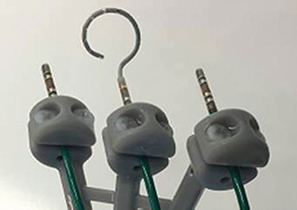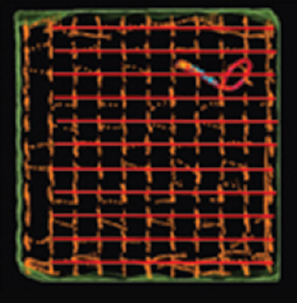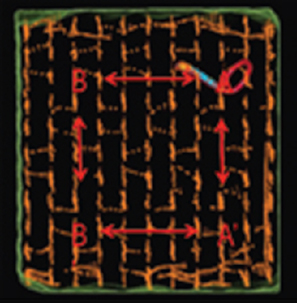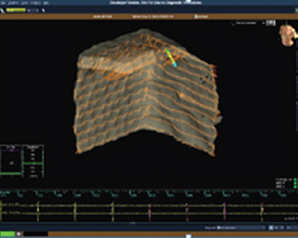Accuracy Testing and Verification¹
Performance bench testing was conducted to verify the tracking and navigation accuracy of the magnetic navigation and visualization technology utilized in the EnSite Precision™ Cardiac Mapping System.
Accuracy Dynamic Wet Lab Study
This study tested the tracking accuracy and the navigation accuracy of the EnSite™ NavX™ Sensor Enabled™ technology in the EnSite Precision module with the FlexAbility™ ablation catheter, Sensor Enabled™ and the Advisor™ FL circular mapping catheter, Sensor Enabled™.

FIGURE 4: DWL fixture showing two FlexAbility ablation catheters, Sensor Enabled and one Advisor FL circular mapping catheter, Sensor Enabled
Testing was performed using a calibrated robotic dynamic wet lab (DWL) to create a 10 cm 3-D geometric cube phantom model using sensor enabled catheter(s) held in an orthogonal fixture (Figure 4).

FIGURE 5a: DWL cube displacement levels
Each catheter movement between 14 horizontal and 10 vertical displacement locations provided multiple electrode measurements during model creation (Figure 5a). Cube models were created using EnSite NavX Navigation and Visualization Technology, Sensor Enabled field scaling in static mode, and in dynamic mode with simulated cardiac (30 - 120 BPM) and respiration (10 - 12 RPM) motion enabled.

FIGURE 5b: Measurements of tracking accuracy (from position A to position B) and navigation accuracy (return to position A)
System error was calculated based on the differences in measurements between the cube models created by the EnSite Precision Cardiac Mapping System and the known dimensions of the phantom cube geometry (Figures 5b and 6).

FIGURE 6: EnSite Precision Cardiac Mapping System display during DWL cube model creation, with automatic EnSite NavX Navigation and Visualization Technology, Sensor Enabled magnetic field scaling enabled
Tracking Accuracy was measured as the error between an induced catheter displacement and the corresponding measured displacement, in this case as catheters were displaced by 50 mm from position A to B. The specified maximum allowable tracking accuracy error in a field scaled model is 10%, or 5.0 mm in this test scenario.
Navigation Accuracy was measured as the error in navigating a catheter back to a defined location (i.e., as catheters were then returned to position A). The specified maximum catheter navigation accuracy error is 2.0 mm with a field scaled model.
Mean tracking accuracy error was under 0.5 mm and maximum tracking accuracy error was well under the specified maximum of 10% over the 50-mm tested displacement value in both static and dynamic test modes.
Mean navigation accuracy was within 0.4 mm for all catheter electrodes tested using the DWL system, with a maximum error of 0.9 mm, also well below the specified maximum value of 2.0 mm (see Table 1 for details).
Accuracy Test Results²
Table 1: Accuracy of EnSite Precision Cardiac Mapping System (v2.0.1) with EnSite NavX Navigation and Visualization Technology, Sensor Enabled Magnetic Field Scaling
| Sensor Enabled Catheters Tested | Tracking Accuracy Error (No. Samples) | Navigation Accuracy Error (No.Samples) |
|---|---|---|
| Advisor™ FL Circular Mapping Catheter, Sensor Enabled™ and Flexibility™ Catheter, Sensor Enabled™ (DWL Phantom Model) | Dynamic: Mean: 0.44 ± 0.45 mm Max: 2.59% Min: -4.11% (n=4032) | Dynamic: Mean: 0.18 ± 0.07 mm Max: 0.38 mm (n=2688) |
| Static: Mean: 0.45 ± 0.49 mm Max: 2.8% Min: -4.37% (n=4032) | Static: Mean: 0.34 ± 0.16 mm Max: .092 mm (n=2688) |
Summary
Tracking and navigation accuracy are important in advanced cardiac mapping and ablation procedures, such as when it becomes necessary to guide a second ablation catheter to the same location as the first.³
The accuracy of the EnSite NavX navigation and visualization technology, Sensor Enabled in the EnSite Precision Cardiac Mapping System has been verified using dynamic bench testing to provide reliable catheter navigation and localization in electrophysiology procedures.
References
- Abbott Medical data on file, Report 90237452.
- Packer, D. L. (2005). Three-dimensional mapping in interventional electrophysiology: techniques and technology. Journal of Cardiovascular Electrophysiology, 16(10), 1110-1116.
- Wittkampf, F. M., Wever, E. F., Derksen, R., Wilde, A. A., Ramanna, H., Hauer, R. N., & Robles de Medina EO. (1999). LocaLisa: new technique for real-time 3-dimensional localization of regular intracardiac electrodes. Circulation, 99, 1312-1317.
MAT-2414995 v1.0
